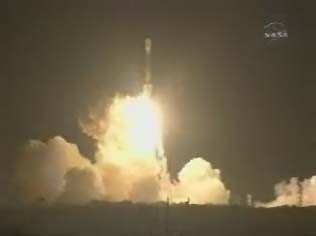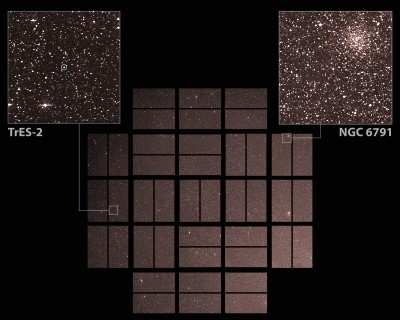Search Continues For Worlds Like Our Own
 NASA's Kepler Mission has released 43 days of science data on
more than 156,000 stars. These stars are being monitored for subtle
brightness changes as part of an ongoing search for Earth-like
planets outside of our solar system.
NASA's Kepler Mission has released 43 days of science data on
more than 156,000 stars. These stars are being monitored for subtle
brightness changes as part of an ongoing search for Earth-like
planets outside of our solar system.
Astronomers will use the new data to determine if orbiting
planets are responsible for brightness variations in several
hundred stars. These stars make up a full range of temperatures,
sizes and ages. Many of them are stable, while others pulsate. Some
show starspots, which are similar to sunspots, and a few produce
flares that would sterilize their nearest planets.
Kepler, a space observatory, looks for the data signatures of
planets by measuring tiny decreases in the brightness of stars when
planets cross in front of, or transit them. The size of the planet
can be derived from the change in the star's brightness.
The 28-member Kepler science team also is using ground-based
telescopes, as well as the Hubble and Spitzer Space Telescopes to
perform follow-up observations on a specific set of 400 objects of
interest. The star field that Kepler observes in the constellations
Cygnus and Lyra can only be seen from ground-based observatories in
spring through early fall. The data from these other observations
will determine which of the candidates can be identified as
planets. That data will be released to the scientific community in
February 2011.

Kepler Launches On A Delta II Rocket 2009
Without the additional information, candidates that are actual
planets cannot be distinguished from false alarms, such as binary
stars -- two stars that orbit each other. The size of the planetary
candidates also can be only approximated until the size of the
stars they orbit is determined from additional spectroscopic
observations made by ground-based telescopes.
"I look forward to the scientific community analyzing the data
and announcing new exoplanet results in the coming months," said
Lia LaPiana, Kepler's program executive at NASA Headquarters in
Washington.
"This is the most precise, nearly continuous, longest and
largest data set of stellar photometry ever," said Kepler Deputy
Principal Investigator David Koch of NASA's Ames Research Center in
Moffett Field, CA. "The results will only get better as the
duration of the data set grows with time."
Kepler will continue conducting science operations until at
least November 2012, searching for planets as small as Earth,
including those that orbit stars in a warm habitable zone where
liquid water could exist on the surface of the planet. Since
transits of planets in the habitable zone of solar-like stars occur
about once a year and require three transits for verification, it
is expected to take at least three years to locate and verify an
Earth-size planet.

Kepler Multiple-Panel View
"The Kepler observations will tell us whether there are many
stars with planets that could harbor life, or whether we might be
alone in our galaxy," said mission science principal investigator
William Borucki of Ames.
Ames is responsible for the ground system development, mission
operations and science data analysis. NASA's Jet Propulsion
Laboratory in Pasadena, CA, managed the Kepler mission development.
Ball Aerospace and Technologies Corp. in Boulder, Colo., developed
the Kepler flight system, and supports mission operations with the
Laboratory for Atmospheric and Space Physics at the University of
Colorado, Boulder. The Space Telescope Science Institute in
Baltimore archives, hosts and distributes the Kepler science
data.
 ANN's Daily Aero-Linx (04.16.24)
ANN's Daily Aero-Linx (04.16.24) Aero-News: Quote of the Day (04.16.24)
Aero-News: Quote of the Day (04.16.24) Airborne 04.10.24: SnF24!, A50 Heritage Reveal, HeliCycle!, Montaer MC-01
Airborne 04.10.24: SnF24!, A50 Heritage Reveal, HeliCycle!, Montaer MC-01 Airborne 04.12.24: SnF24!, G100UL Is Here, Holy Micro, Plane Tags
Airborne 04.12.24: SnF24!, G100UL Is Here, Holy Micro, Plane Tags Airborne-Flight Training 04.17.24: Feds Need Controllers, Spirit Delay, Redbird
Airborne-Flight Training 04.17.24: Feds Need Controllers, Spirit Delay, Redbird





